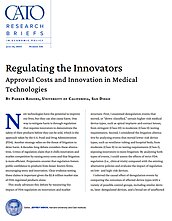This study advances this debate by measuring the impact of FDA regulation on innovation and market structure. First, I examined deregulation events that moved, or “down-classified,” certain higher-risk medical device types, such as spinal implants and contact lenses, from stringent (Class III) to moderate (Class II) testing requirements. Second, I considered the litigation alternative by analyzing events that moved lower-risk device types, such as ventilator tubing and hospital beds, from moderate (Class II) to no testing requirements (Class I), exposing innovators to more litigation. By analyzing both types of events, I could assess the effects of strict FDA regulation (i.e., clinical trials) compared with the existing alternative policies and evaluate the impact of regulation on low- and high-risk devices.
I inferred the causal effect of deregulation events by comparing the outcomes of affected device types with a variety of possible control groups, including similar devices, later-deregulated devices, and a broad set of unaffected devices. Importantly, my findings remain consistent across all these groups, reinforcing their reliability. Moreover, innovators themselves describe these deregulation events as unpredictable, which aligns with my finding that there were no divergent trends in the outcomes between the deregulated devices and the comparison group devices before deregulation. This lack of divergent trends, combined with the unpredictable nature of these deregulation events and the consistent results observed across various comparison groups, supports my conclusion about the true effects of deregulation.
Gathering data for my analysis was a unique challenge due to the fragmented nature of information on the many factors affected by FDA regulation. To address this challenge, I used text analysis algorithms and manual linkages to construct a comprehensive data set. This data set offers a detailed four-decade account of device innovation, innovator characteristics, innovation quality, market structure, prices, and device safety.
My analysis of this data shows that down-classification events increase the quantity and quality of new technologies. Following the transition from Class III (high regulation) to Class II (moderate), device types exhibited a 200 percent increase in patent filings and FDA submissions compared with control groups. Patents filed after these events were also of significantly higher quality, as measured by a 200 percent increase in citations received and market valuations. These effects do not spill over into similar device types. For Class II to Class I deregulations, patent filings increased by 50 percent, and the quality of patent filings improved tenfold, suggesting that litigation discourages innovation less than regulation. Interestingly, the increase in innovation was strongest among smaller firms and those with limited regulatory experience, which are also the firms most likely to produce groundbreaking innovation.
Second, these deregulation events led to significant changes in market structure. Class III to Class II events resulted in a tenfold increase in new entry (firms without approved devices) and a fourfold increase in incumbent entry (firms with approved devices of another type) into the deregulated device types. The heightened competition reduced the prices of medical procedures using deregulated device types by 40 percent, based on claims data from a university hospital system. Similarly, Class II to Class I events led to a 200 percent increase in new entry for the treated device types, with no effect on incumbent entry, suggesting that litigation obstructs new firm entry less than regulation.
Down-classification yields considerable benefits, as the proponents of deregulation would predict, but what of product safety? I find that deregulation can improve product safety by exposing firms to more litigation. Despite some adverse event rates increasing after Class III to Class II events, Class II to Class I events are associated with significantly lower adverse event rates. Furthermore, an analysis of patent texts reveals that inventors focus more on product safety after deregulation. These results suggest that litigation encourages product safety more effectively than regulation does: instead of meeting Class II requirements, which the National Academy of Medicine deems insufficient for ensuring product safety, inventors must reduce the likelihood of their products causing harm to consumers to avoid litigation. I further investigated the role of litigation concerns in improving product safety by using variation in firms’ exposure to litigation after deregulation: smaller firms expect less liability as they can use bankruptcy to avoid liability exceeding their assets. I find that safety improvements are strongest among larger firms for which a larger share of liability is unavoidable.
A simple calculation suggests that the benefits of these events outweigh the costs. Accounting for the cost of adverse events, the value of increased innovation, and reduced health care prices, the unmeasured costs of Class III to Class II events would need to be larger than the measured costs to justify Class III regulation. For Class II to Class I events, there are virtually no measurable costs of down-classifications, given the decline in adverse events. By contrast, the benefits of these events amount to over $22 million per device type annually. Although these benefits are based on the analysis of certain device types already deregulated, I find evidence that these benefits may extend to current Class II device types as well: deregulated device types posing the greatest risks, according to the FDA, experience the most substantial decreases in adverse events. If this relationship holds, the potential yearly forgone benefits could reach as high as $55 billion across 2,500 current Class II device types, representing nearly 32 percent of the annual value of purchased medical devices. Overall, this research provides evidence that deregulation can enhance product safety, accelerate innovation, reduce health care prices, and empower small firms and those with less regulatory experience.
NOTE
This research brief is based on Parker Rogers, “Regulating the Innovators: Approval Costs and Innovation in Medical Technologies,” February 2023.

